The frontosa fish is an exceptionally beautiful freshwater cichlid that captivates aquarists, particularly cichlid enthusiasts. Known for their striking appearance, frontosas exhibit deep and contrasting colors that vary from blues to yellows, depending on their environment and breeding. Frontosas are best suited for experienced aquarists due to their specific care requirements. These fish can grow quite large, often reaching lengths of up to 12 inches, which necessitates ample tank space. Additionally, they thrive in well-maintained, stable environments that mimic their natural habitats, typically found in deep, rocky areas of Lake Tanganyika in Africa.
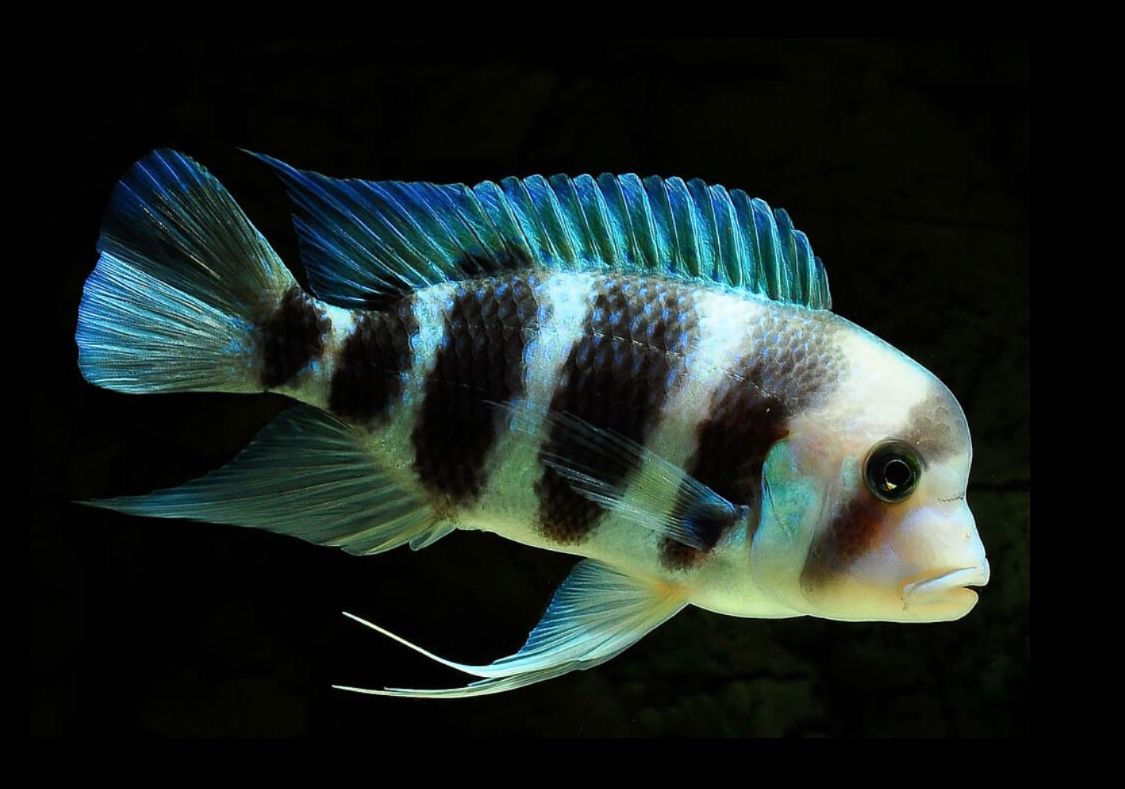
Contents
Habitat in the wild
The frontosa family refers to a captivating group of fish species within the Cichlidae family, particularly from the genus Cyphotilapia. The most renowned member of this family is the frontosa cichlid, scientifically known as Cyphotilapia frontosa.
Native to Lake Tanganyika in East Africa, which is bordered by Tanzania, the Democratic Republic of Congo, Zambia, and Burundi, frontosa cichlids thrive in this unique ecosystem. Lake Tanganyika is the second deepest lake in the world and boasts an extraordinary biodiversity, including a myriad of cichlid species, making it a fascinating location for aquatic life.
Unlike many other cichlid species that seek shelter among rocks and vegetation, frontosa cichlids prefer to form large colonies along the rocky coasts of the lake. They inhabit both shallow and deeper waters, typically found near rocky outcrops, drop-offs, and sandy substrates. These environments provide essential shelter, hiding spots, and territory establishment areas.
The diverse habitats of Lake Tanganyika, which include rocky shorelines, sandy bottoms, and regions with submerged vegetation, offer frontosa cichlids ideal conditions to thrive. They are often located near rocky structures where they can assert their territories and create spawning sites. Remarkably, these fish dig pits in the sandy substrates as part of their breeding behavior, showcasing their unique reproductive strategies.
In terms of water parameters, Lake Tanganyika features a relatively high mineral content, with pH levels ranging from 7.8 to 9.0 and temperatures typically around 24-27°C (75-81°F). Within this rich aquatic environment, cichlids are one of the dominant fish groups, and frontosa cichlids coexist harmoniously with various other species. Their behaviors and interactions are intricately linked to the complex ecosystem of the lake.
Thanks to successful fish-farming practices, frontosa cichlids are now readily available for sale, allowing aquarists to appreciate their beauty and complexity in home aquariums.
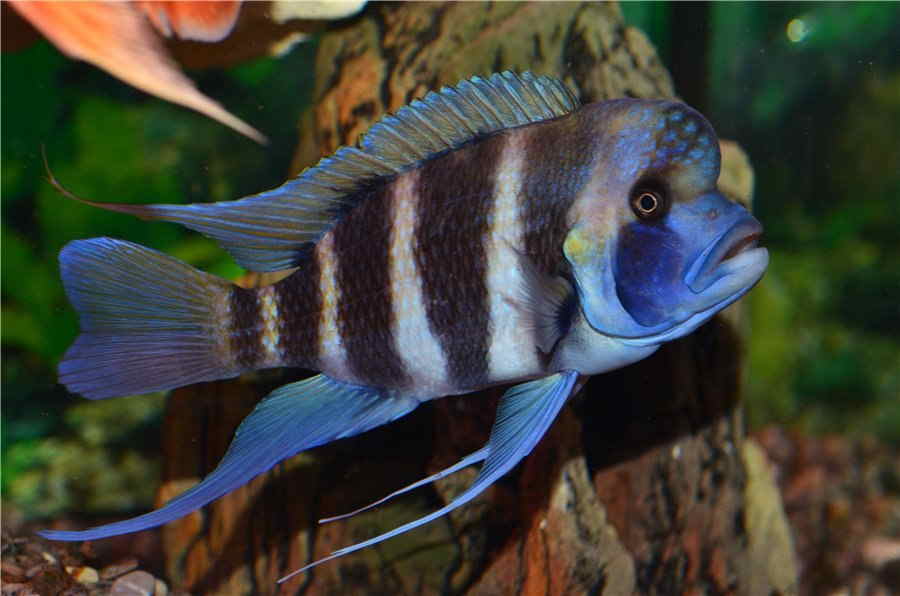
Description
Physical Characteristics
Frontosa cichlids are known for their deep-bodied shape, characterized by a tall and elongated physique that gives them a robust and powerful appearance. Their body color can range from grey-blue to grey-white, with some variants exhibiting striking black coloration. The head and fins typically showcase bluish hues, and their bodies are adorned with 6 to 7 vertical black stripes of varying widths. The exact pattern and intensity of these stripes can differ depending on the geographic variant or locality.
Distinctive Features
One of the most distinctive features of frontosa cichlids is their prominent humped forehead, which bulges outward, creating a unique profile. The size and shape of the forehead can vary among individuals, with the hump beginning to develop once the fish reaches about 4 inches (10 cm) in length. Males typically have larger humps than females, and as frontosas age, this bump becomes more pronounced, serving as an indicator of their age and strength.
Fins and Body Structure
As frontosa cichlids mature, their coloration tends to darken, and their fins become longer. Males exhibit elongated dorsal and pectoral fins with pointed tips, while females possess shorter fins. The dorsal fin, located along the fish’s back, extends significantly along its body, and the anal fin, situated on the ventral side, is also elongated but slightly shorter than the dorsal fin. The pectoral and pelvic fins, in contrast, are relatively small. This fin structure not only contributes to their appearance but also plays a role in their swimming abilities and overall agility in the water.
Size and Growth
When it comes to size, frontosa cichlids can grow to be quite large, especially males. On average, adult males typically reach lengths of about 14 to 16 inches (35 to 40 cm) from the tip of the nose to the end of the tail, while females are generally smaller, reaching lengths of up to 10 inches (25 cm). Their deep-bodied shape contributes to their significant weight, with large males often weighing several pounds, enhancing their impressive presence in any aquarium.
Growth Rate
Frontosa cichlids have a relatively slow growth rate compared to many other aquarium fish. Their growth is influenced by factors such as genetics, diet, water conditions, tank size, and overall care. Typically, they experience a growth spurt during their first year of life, reaching lengths of 2 to 3 inches (5 to 8 cm) within the first six months. By their first birthday, they can measure between 4 and 6 inches (10 to 15 cm). After this initial growth phase, their growth rate slows, and they may gain only a fraction of an inch per year until they reach their maximum size.
| Age | Size |
| 6 months | 2-3 inches (5-8 cm) |
| 1 year | 4-6 inches (10-15 cm) |
| 2 years | 6-8 inches (15-20 cm) |
| 3 years | 8-10 inches (20-25 cm) |
| 4 years | 10-12 inches (25-30 cm) |
| 5 years | 12-14 inches (30-35 cm) |
| 6 years and up | 14-16 inches (35-40 cm) |
| Characteristic | Description |
|---|---|
| Scientific Name | Cyphotilapia frontosa |
| Common Names | Frontosa cichlid, Frontosa |
| Size | Males: Up to 14-16 inches (35-40 cm) Females: Up to 10 inches (25 cm) |
| Lifespan | 15-20 years or longer with proper care |
| Body Shape | Deep-bodied and elongated |
| Forehead | Prominent humped forehead |
| Coloration | Blue-black body with white or blue stripes and spots |
| Behavior | Generally peaceful, but can be territorial and aggressive if crowded or during breeding |
| Habitat | Lake Tanganyika, East Africa |
| Preferred Water Parameters | Temperature: 24-27°C (75-81°F) pH: 7.8-9.0 Hardness: 8-12 dH |
| Diet | Piscivorous in the wild, but can be fed high-quality pellets supplemented with occasional live or frozen foods |
| Breeding Method | Mouthbrooders, females hold eggs in their mouths until hatching |
| Conservation Status | Not evaluated, but stable populations exist in their natural habitat |
Types of frontosa fish
Regional Variations in Cyphotilapia frontosa
Within the species Cyphotilapia frontosa, there are notable regional variations in coloration and patterning due to geographic isolation within Lake Tanganyika. These variations, often referred to as “variants” or “localities,” are highly valued by enthusiasts and contribute to the rich biodiversity of this species. Each variant exhibits unique characteristics that make them particularly appealing to aquarists.
Types of Coloring
Burundi Variant
The Burundi variant features a pale blue body adorned with five vertical black bands. A distinctive sixth band runs from the forehead along the eye to the opercle insertion, creating a striking contrast against its body color. This variant is known for its vibrant appearance and is one of the most sought-after due to its stunning coloration and robust health.
Blue Zaire Kapampa
This variant is recognized for its saturated, moderately blue-colored fins. The upper part of the body and the nape display an opalescent sheen. A dark band stretches from between the eyes to the mouth, while the pelvic fin and light vertical bands also exhibit a moderate blue hue. The Blue Zaire Kapampa is often noted for its calm demeanor, making it a good choice for community tanks.
Kavalla Variant
The Kavalla variant showcases five bold black bands with yellowish membranes on the dorsal fin, which provide a vivid appearance that stands out in any aquarium setting. Its eye-catching coloration makes it a favorite among aquarists looking to enhance their tanks with beautiful specimens.
Kigoma Variant
The Kigoma variant is distinguished by six black bands and dark blue cheeks that can appear almost black. The dorsal fin is yellowish, and the vertical bands are either white or a combination of white and blue. A unique feature of this variant is the band over the eye, which appears somewhat stunted, resembling a stain. Additionally, the dorsal and fluke membranes exhibit a yellowish tint. This variant is noted for its active behavior and territorial nature, particularly during breeding.
Kipili Variant
The Kipili variant possesses five black stripes, similar to other variants, but it is unique for its black opercles. It also features a horizontal stripe between the eyes, resembling markings seen in the Blue Sambia variant. This variant is particularly appreciated for its resilience and adaptability to varying water conditions.
Blue Mpimbwe
The Blue Mpimbwe variant is notable for its blue head and fins, which become increasingly saturated and vibrant as the fish matures. The coloration of these fish lies somewhere between that of the Burundi and Nord Congo variants. This transition in color is often seen as an indicator of the fish’s health and maturity.
Nord Congo Variant
This variant features a pale blue body adorned with five vertical black bands, similar to the Burundi variant. The distinctive sixth band also runs from the forehead along the eye to the opercle insertion. The Nord Congo variant is known for its peaceful temperament, which makes it compatible with other species in community tanks.
Blue Sambia
The Blue Sambia variant exhibits a blue head and fins, with light-colored bands on the body that are highlighted by a blue outline. A prominent dark band is visible between the eyes, enhancing its striking appearance. This variant is often more rare and sought after, leading to higher market prices among collectors.
Moba Zaire Variant
The Moba Zaire variant is unique due to its dramatic color variations, which can range from ultramarine to light violet. This variability makes it an intriguing choice for aquarists looking for diversity within their tanks. The Moba variant is also known for its strong, healthy lineage, often thriving in both natural and aquarium environments.
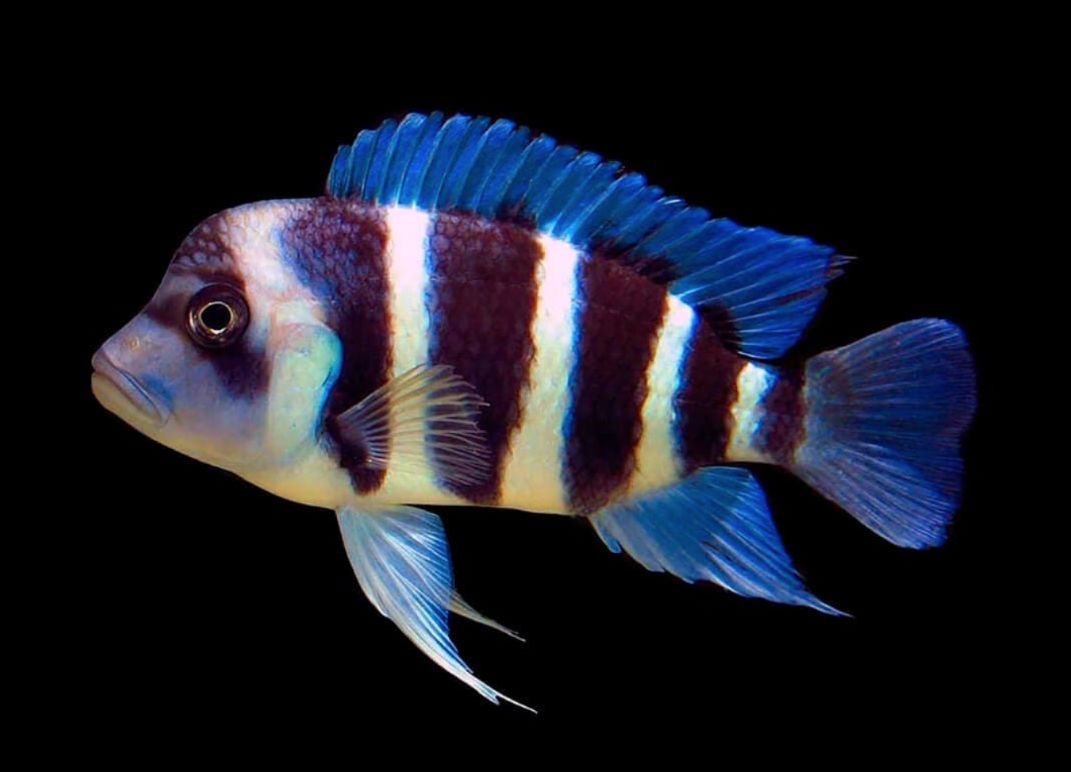
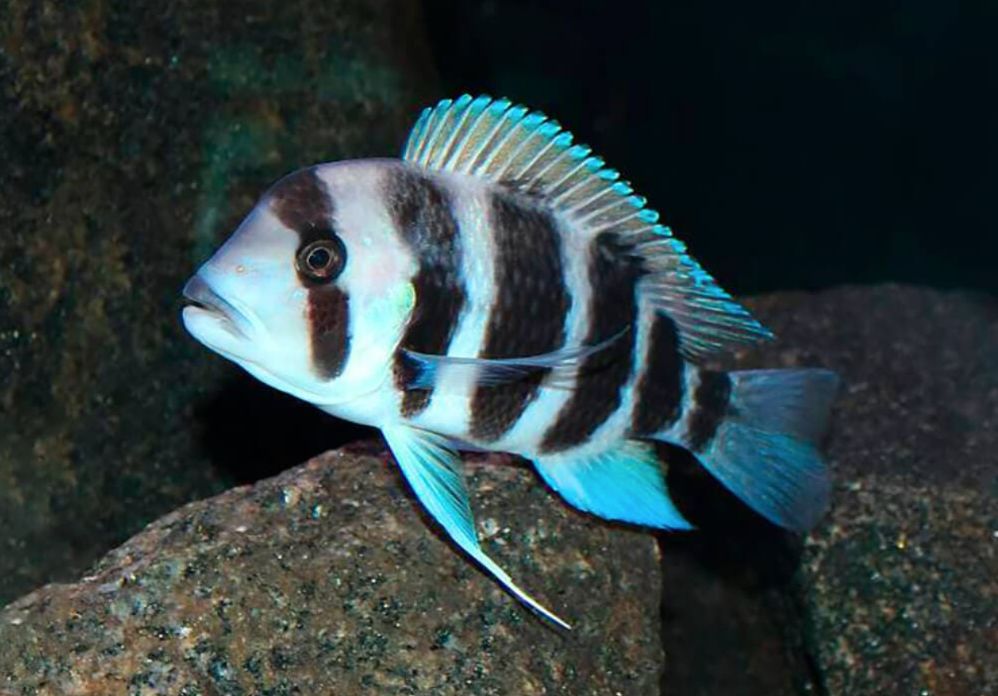
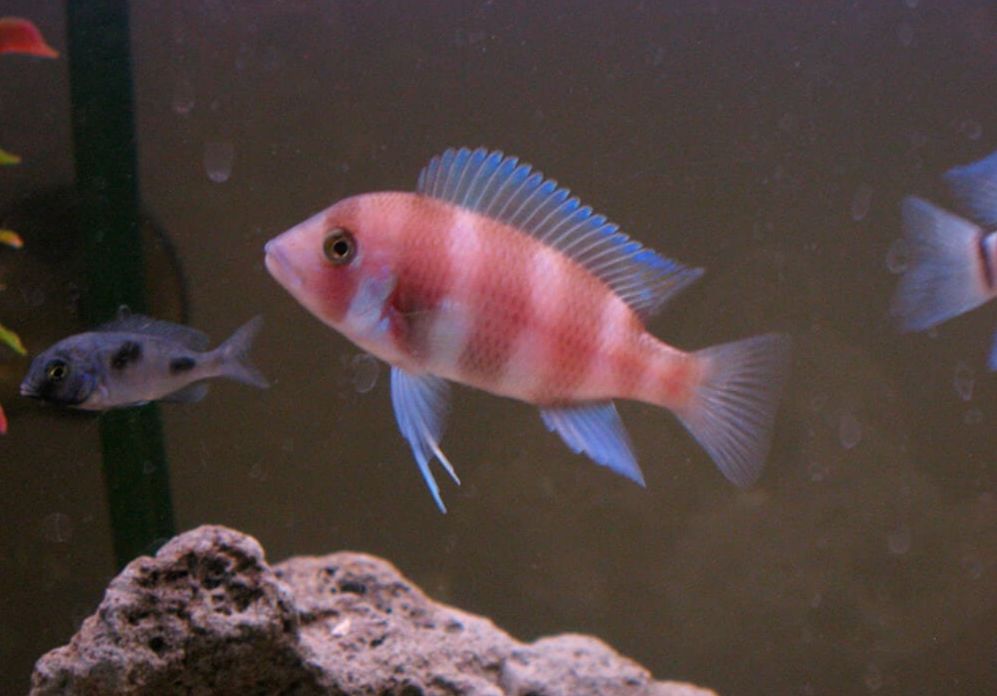
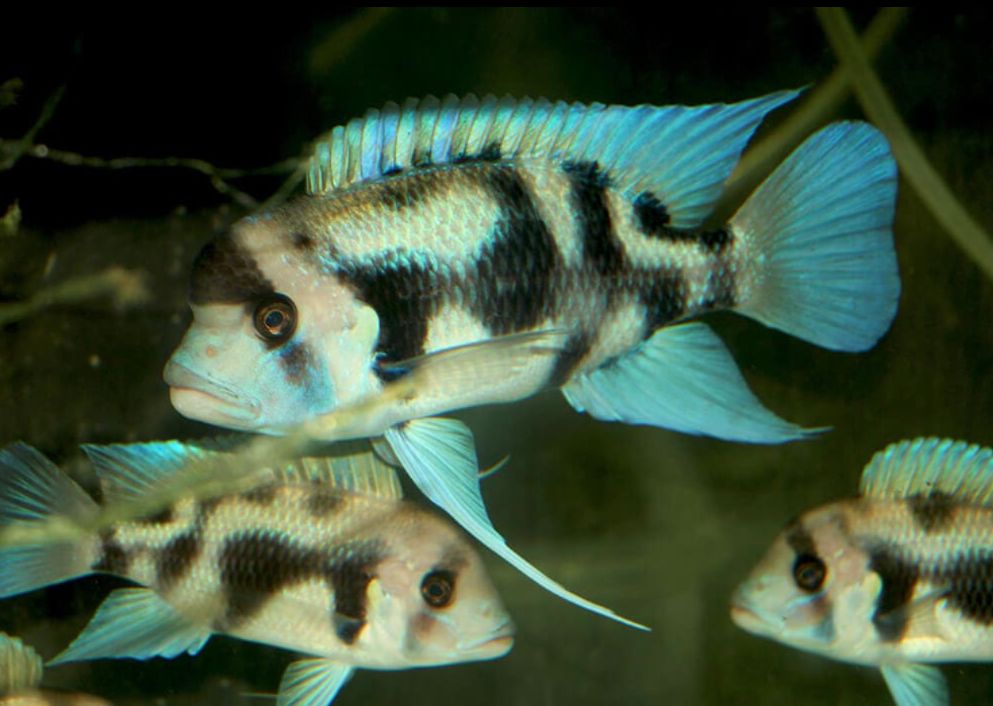
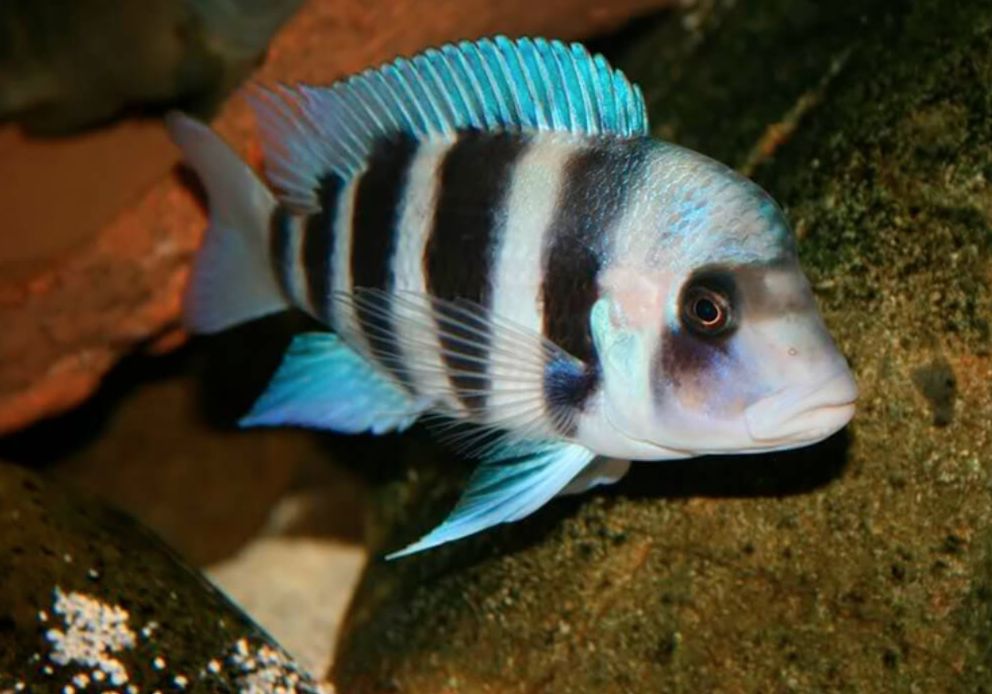
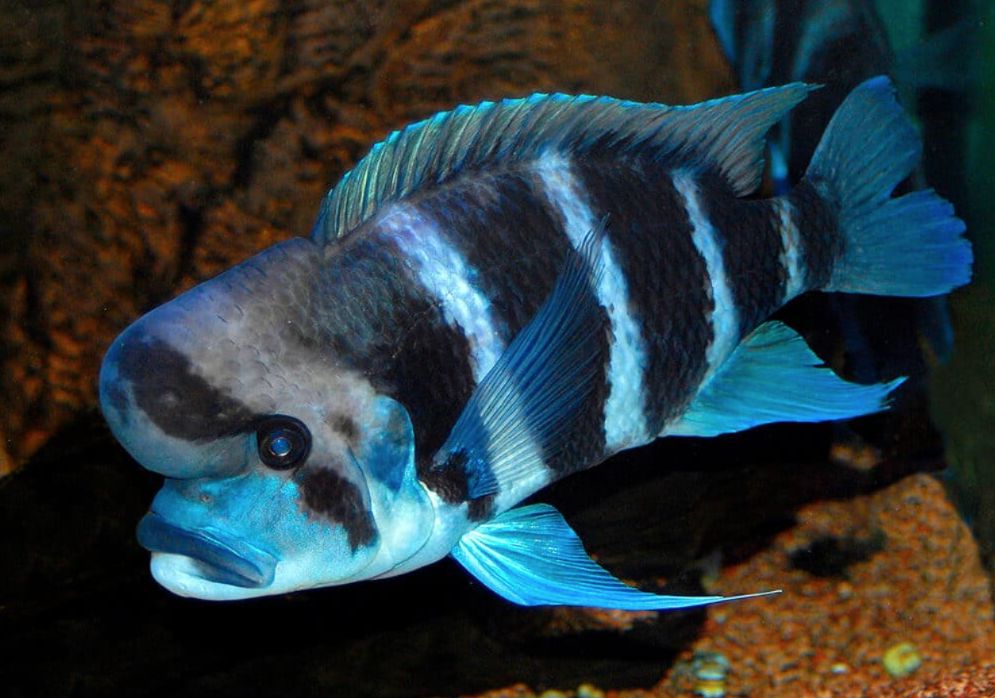
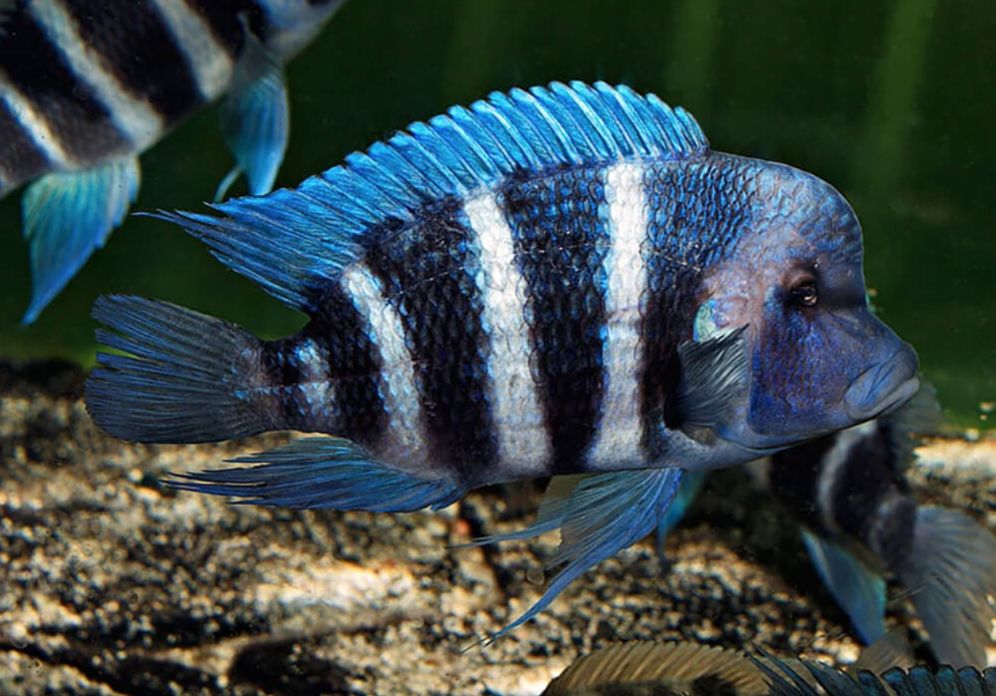
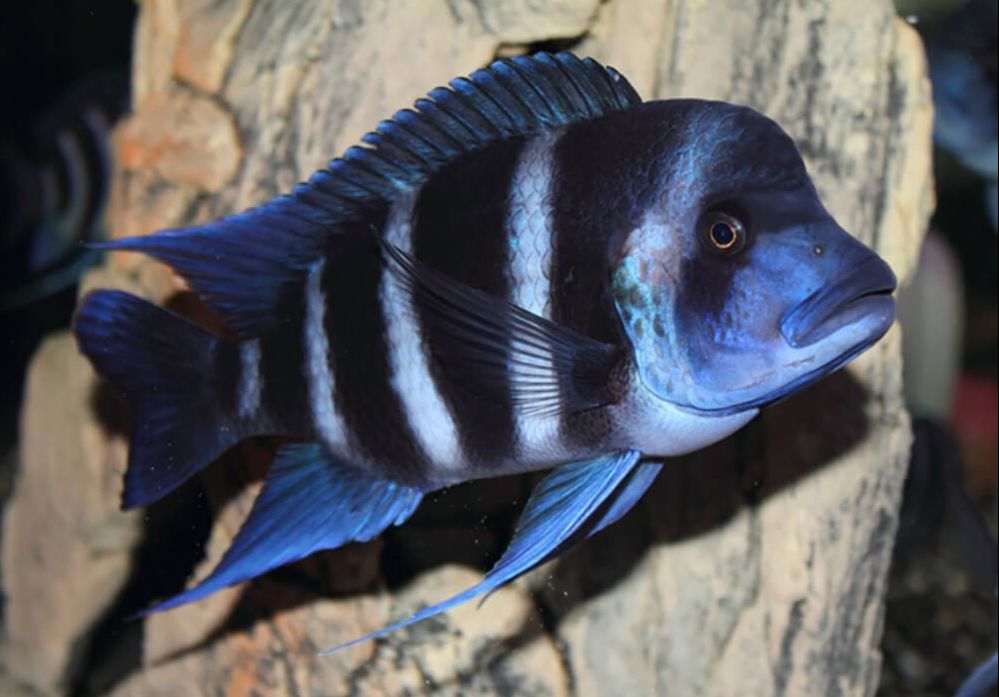
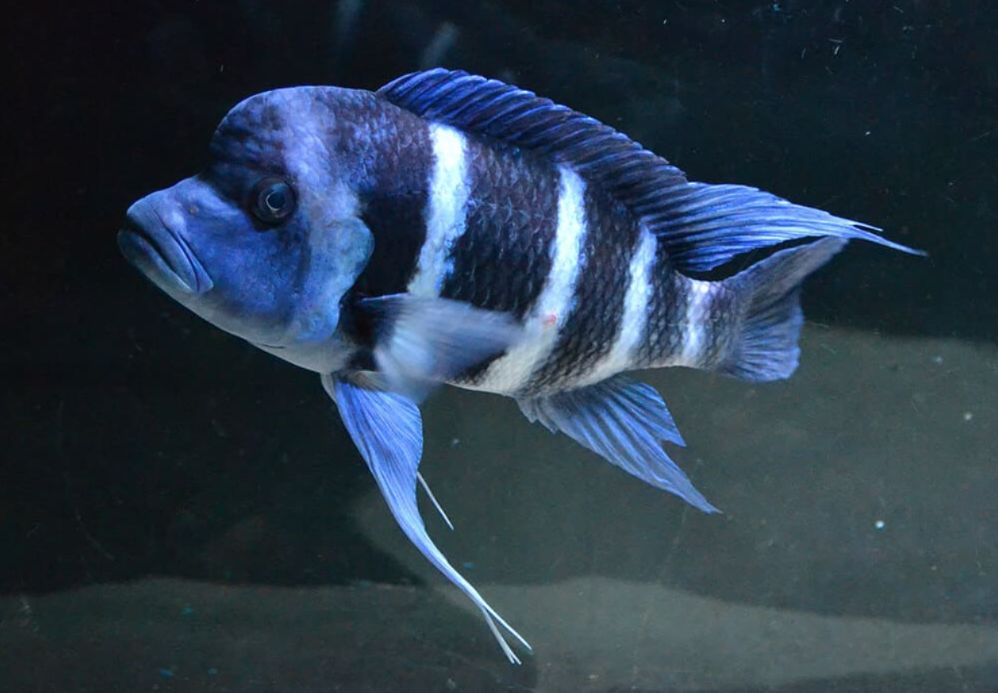
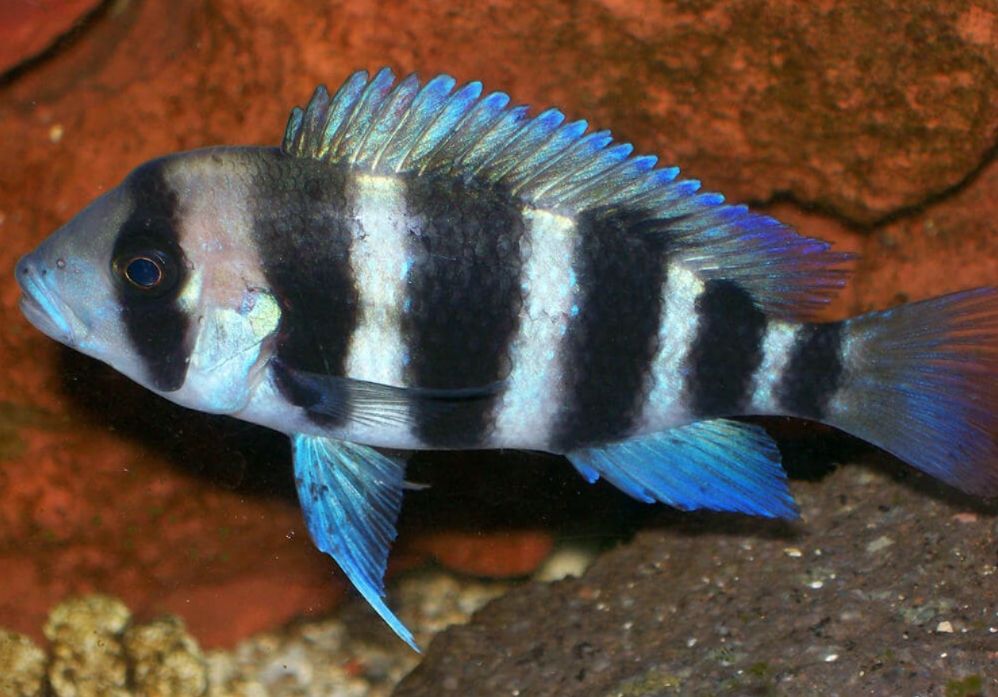
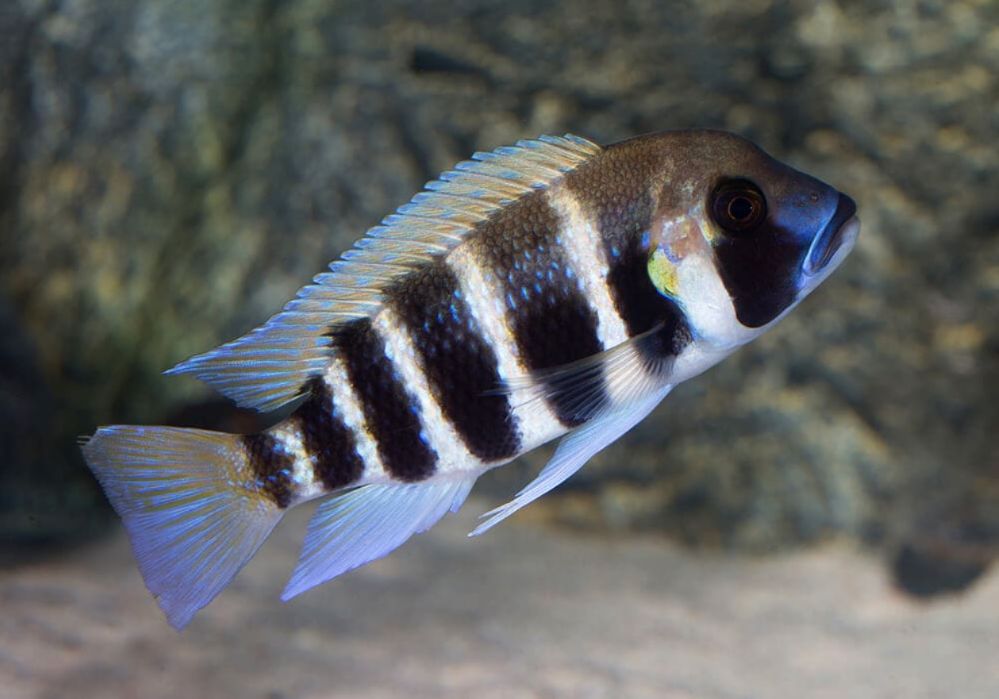
Difficulties in keeping
Is a fish for experienced aquarists, since the frontosa cichlid requires a spacious tank with clean water and frequent water renew and also tank mates should be chosen correctly.
This is one of the most calm cichlids that can be even kept with other large fishes, however as any large raptorial feeder and it’ll feed on small fish. Frontosa cichlid is a slow fish which doesn’t keep it from being Lake Tanganyika queen cichlid and raptorial feeder. In the wild cichlid spends a little energy to stalk its prey. These fish advantage is that they are nocturnal feeders and they don’t need a lot of light.
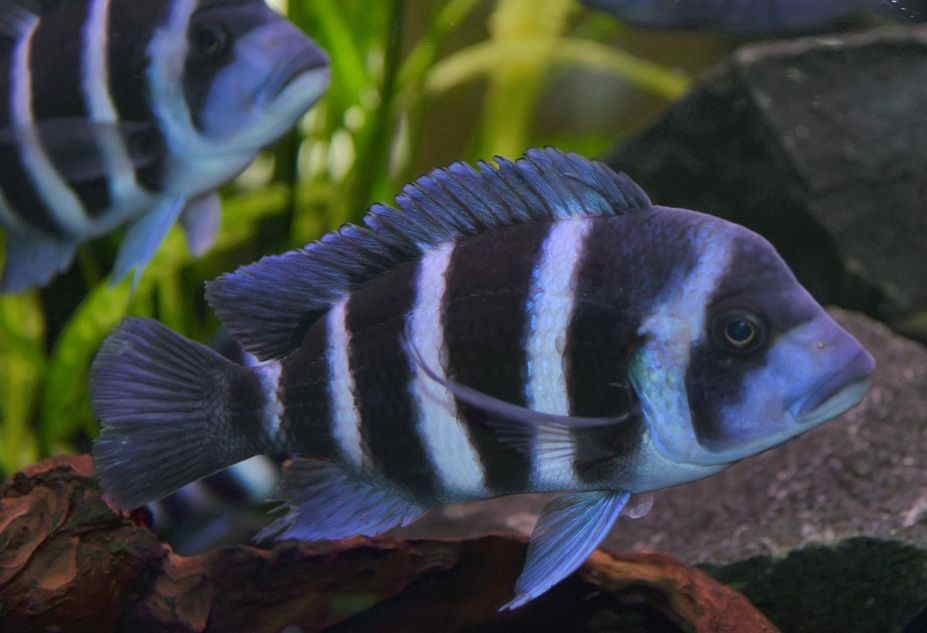
Diet
Frontosa cichlids are primarily piscivorous in the wild, meaning they feed on smaller fish, but in an aquarium setting, their diet can be varied to ensure proper nutrition. While live food is the most preferred option for these fish, providing a balanced diet is essential for their health and vitality.
Their diet can include prawns, earthworms, and small fish, whether fresh or frozen. However, it is important to avoid feeding them bloodworms, as these are not beneficial for their health in the long term. To enhance their diet further, occasional servings of live or frozen foods can be included, which not only provide additional nutrients but also stimulate their natural hunting instincts. Suitable options for these occasional treats include brine shrimp, daphnia, and small feeder fish, such as guppies, which can also be introduced into their feeding routine as part of a varied diet.
The primary component of a frontosa’s diet in captivity should be high-quality, protein-rich pellets specifically formulated for cichlids. When selecting pellets, look for those that contain a balanced blend of animal proteins, vitamins, and minerals to support their growth and overall health. The size of the pellets should be appropriate for their mouth size, ensuring that they can consume them comfortably.
Frontosa cichlids are not overly active feeders, often exhibiting a more relaxed approach to feeding. As such, it is best to feed them once or twice a day, offering an amount of food they can consume within a few minutes. Overfeeding should be avoided, as it can lead to obesity and associated health issues, compromising the fish’s well-being and longevity. By adhering to a well-rounded diet and feeding schedule, aquarists can help maintain the vibrant coloration and robust health of their frontosa cichlids, allowing these beautiful fish to thrive in their aquatic environment.
To promote optimal health and color vibrancy, it’s also beneficial to occasionally include vegetable matter in their diet, such as spirulina flakes or blanched zucchini. This addition can aid in digestion and provide essential fiber, contributing to their overall nutritional balance. Additionally, ensuring a clean and well-maintained tank environment will support their feeding habits and enhance their quality of life, as these cichlids thrive in stable conditions with proper water parameters.
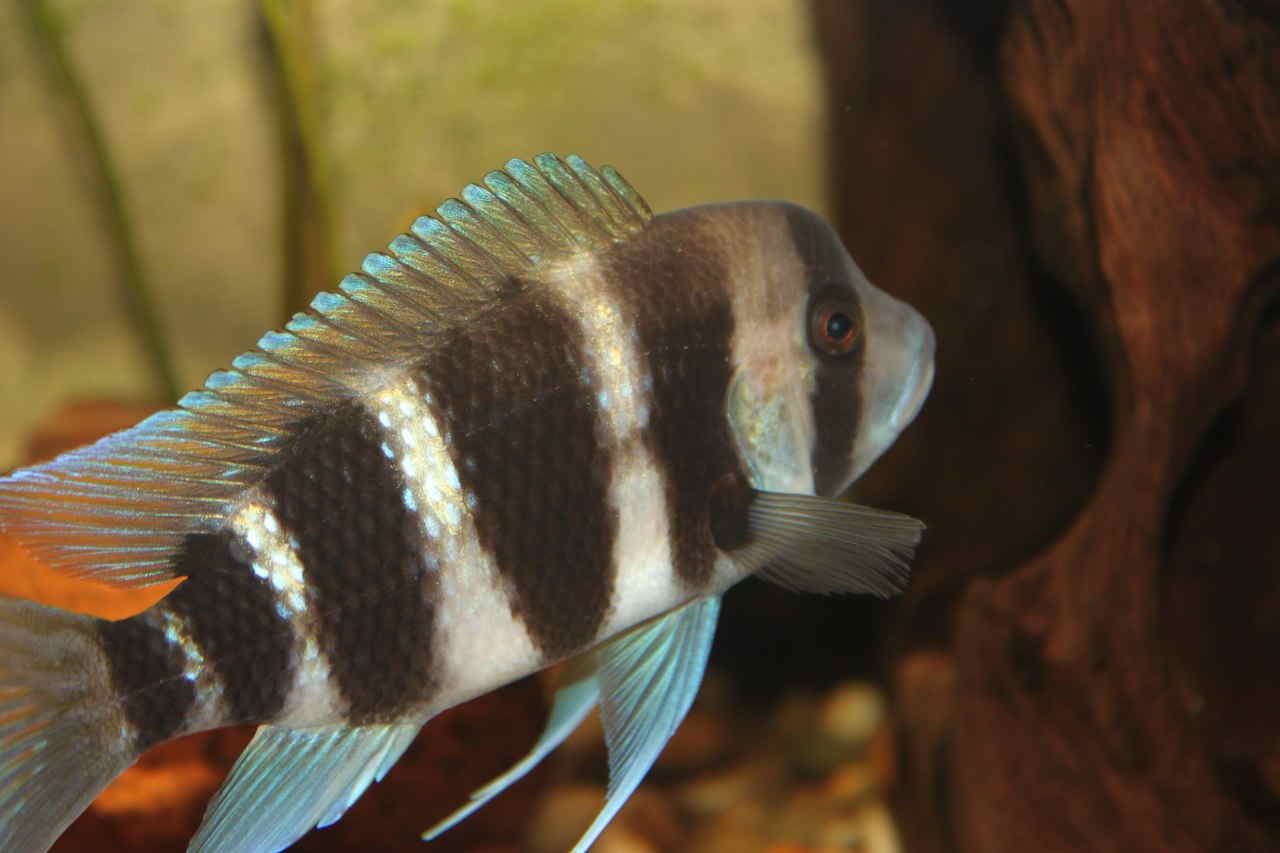
Care and keeping in a tank
Tank size
Frontosa cichlids are large fish that require a spacious tank to accommodate their size and behavioral needs. A larger tank not only provides adequate swimming space but also helps reduce territorial conflicts among the fish, ensuring a more harmonious environment. For a single frontosa cichlid or a small group of juveniles, a minimum tank size of 75 gallons (284 liters) is recommended. However, it’s essential to recognize that this is just the minimum requirement; providing a larger tank is always more beneficial for their well-being.
Frontosa cichlids are social fish that thrive when kept in groups. Therefore, if you plan to keep a group of adult frontosa cichlids, a larger tank is necessary to prevent overcrowding and territorial disputes. Ideally, a tank size of 125 gallons (473 liters) or more is recommended for a group of 4-6 adult cichlids. This size allows them to establish territories without feeling cramped, which is crucial for their social dynamics.
When considering tank dimensions, it’s important to remember that frontosa cichlids appreciate a long tank to facilitate their natural swimming behavior. A tank with a length of at least 4 feet (120 cm) is ideal, providing enough room for these elongated fish to move freely. Additionally, frontosa cichlids have a deep-bodied shape, so incorporating vertical space in the tank is beneficial. Tanks with a height of 20-24 inches (50-60 cm) or more can accommodate their needs, allowing them to explore both horizontally and vertically.
Ultimately, investing in a spacious and well-structured tank will significantly enhance the health and happiness of frontosa cichlids, as they require an environment that mirrors their natural habitat in Lake Tanganyika, characterized by rocky outcrops and ample space to establish territories and socialize. A well-maintained tank will not only improve the quality of life for these stunning fish but also enable them to exhibit their natural behaviors, resulting in a vibrant and lively aquarium. Regular water changes and appropriate filtration are also essential to maintaining optimal water quality, which is crucial for the health of frontosa cichlids.
Water parameters
Lake Tanganyika is considered the second largest lake in the world, which contributes to the stability of its water temperature and pH. This stable environment is crucial for the various species of cichlids that inhabit the lake, including frontosa cichlids. All Lake Tanganyika cichlids require consistent water conditions, particularly a stable temperature and a high concentration of dissolved oxygen.
To maintain these ideal conditions, regular water changes are necessary. Additionally, installing a powerful canister filter in the tank is essential, as cichlids can be quite sensitive to water purity and parameters. A good filtration system not only helps remove waste and toxins but also promotes water circulation and increases oxygen saturation. These factors are particularly important for fish that naturally inhabit waters rich in dissolved oxygen, allowing them to thrive in an aquarium setting.
Even with a powerful filter, incorporating additional aeration into the tank setup is beneficial. This can be achieved through air stones or other aeration devices, which further enhance oxygen levels in the water.
The ideal temperature range for keeping frontosa cichlids is between 22–30 °C (72–86 °F). Water hardness in Lake Tanganyika typically measures around 12-14° dGH, while the pH level ranges from 8.0 to 8.5, indicating that the water is relatively hard and slightly alkaline. Maintaining these specific parameters can be challenging for aquarists who live in areas with naturally soft water. To increase water hardness, many choose to add coral pebbles or other calcium-rich substrates to the tank, which helps to buffer the water and stabilize pH levels.
Regular monitoring of water quality is crucial, and testing kits should be used to keep track of essential parameters. It is equally important to avoid overfeeding and preventing overpopulation within the tank, as these issues can lead to deteriorating water quality. Frontosa cichlids can adapt well to a tank environment that closely mimics these natural conditions. It’s important that any changes in water parameters occur gradually, as abrupt fluctuations can stress the fish. Frequent, smaller water changes are preferred to maintain optimal living conditions, ensuring the health and vitality of the frontosa cichlids.
Tank decor
While plants in an aquarium may not play a critical role, incorporating some stiff-leaved and larger types of plants can enhance the visual appeal of the tank. Frontosa cichlids typically do not interact heavily with plants, but adding hardy and robust species can provide some enrichment and aesthetic variety. Suitable options include Java ferns, Anubias, and Vallisneria, which are capable of tolerating the higher pH and alkaline conditions favored by frontosa cichlids. It’s essential to secure these plants firmly in the substrate or use plant-safe weights, as cichlids may uproot or damage them during their movements.
Frontosa cichlids are primarily bottom dwellers, and using a sandy substrate closely mimics their natural habitat. Fine-grained sand is the ideal choice, allowing these fish to sift and dig without injuring themselves. This type of substrate not only promotes natural behavior but also supports their well-being. In addition to sand, providing some cover in the form of large rocks or driftwood is important, as frontosas are somewhat timid and enjoy having hiding spots.
Given their natural habitat in the rocky coastal areas of Lake Tanganyika, incorporating plenty of rocks and caves into the aquarium is crucial. These structures offer essential hiding spots, territories, and breeding areas for the fish, contributing to their comfort and reducing stress. When arranging the rocks, it’s important to create cave-like structures that also allow for open swimming spaces. Use sturdy, heavy rocks that will not easily topple when the large fish attempt to hide or navigate around them. Ensuring that the rocks are securely positioned is vital for preventing any accidents that could injure the frontosa cichlids.
Overall, a thoughtfully designed aquarium with a sandy substrate, robust plants, and ample rocky structures will not only reflect the natural environment of frontosa cichlids but also promote their health and well-being in captivity.
Tank mates
Frontosa cichlids are generally not very aggressive; however, they are territorial and will defend their space vigorously. For this reason, it’s often best to keep them alone in a tank without any tank mates. Being raptorial feeders, they will also consume any fish small enough to fit into their mouths. Therefore, while they can be kept in small groups—ideally one male with three females or larger groups of 8 to 12 individuals—careful consideration of tank mates is necessary to ensure compatibility.
Some suitable tank mate options for frontosa cichlids include:
Keeping multiple frontosa cichlids together can be a viable option, especially in a spacious tank. It’s advisable to maintain groups of six or more to help distribute aggression and establish a natural hierarchy among the fish. However, be prepared for potential territorial disputes and ensure that there are adequate hiding spots and territories to minimize conflicts.
Selecting other cichlid species that are native to Lake Tanganyika can also work well as tank mates. Species such as Julidochromis, Neolamprologus, and Altolamprologus tend to be peaceful or semi-aggressive and can coexist with frontosas. It’s crucial to research the specific requirements and temperaments of any additional species to ensure they are compatible with frontosa cichlids.
Certain Synodontis catfish, such as upside-down catfish or pictus catfish, can thrive alongside frontosa cichlids. These bottom-dwelling catfish can contribute to keeping the tank clean while avoiding direct competition for food and space with frontosas.
Larger African tetra species, like congo tetras, can also be considered as tank mates. These tetras are roughly the same size and are generally robust enough to coexist in a cichlid environment.
In a sufficiently spacious tank with ample hiding spots, you can think about including other large, peaceful species such as silver dollars, giant gourami, or certain larger barbs like tinfoil barbs. It’s essential to ensure that these tank mates are not overly aggressive or prone to fin-nipping, as this can stress the frontosas.
When introducing new tank mates, monitor the situation closely to ensure that all fish adjust well to each other. Pay attention to any signs of aggression or stress, and be ready to separate any incompatible species if necessary. A well-planned community tank can provide a vibrant and dynamic environment for frontosa cichlids and their companions.
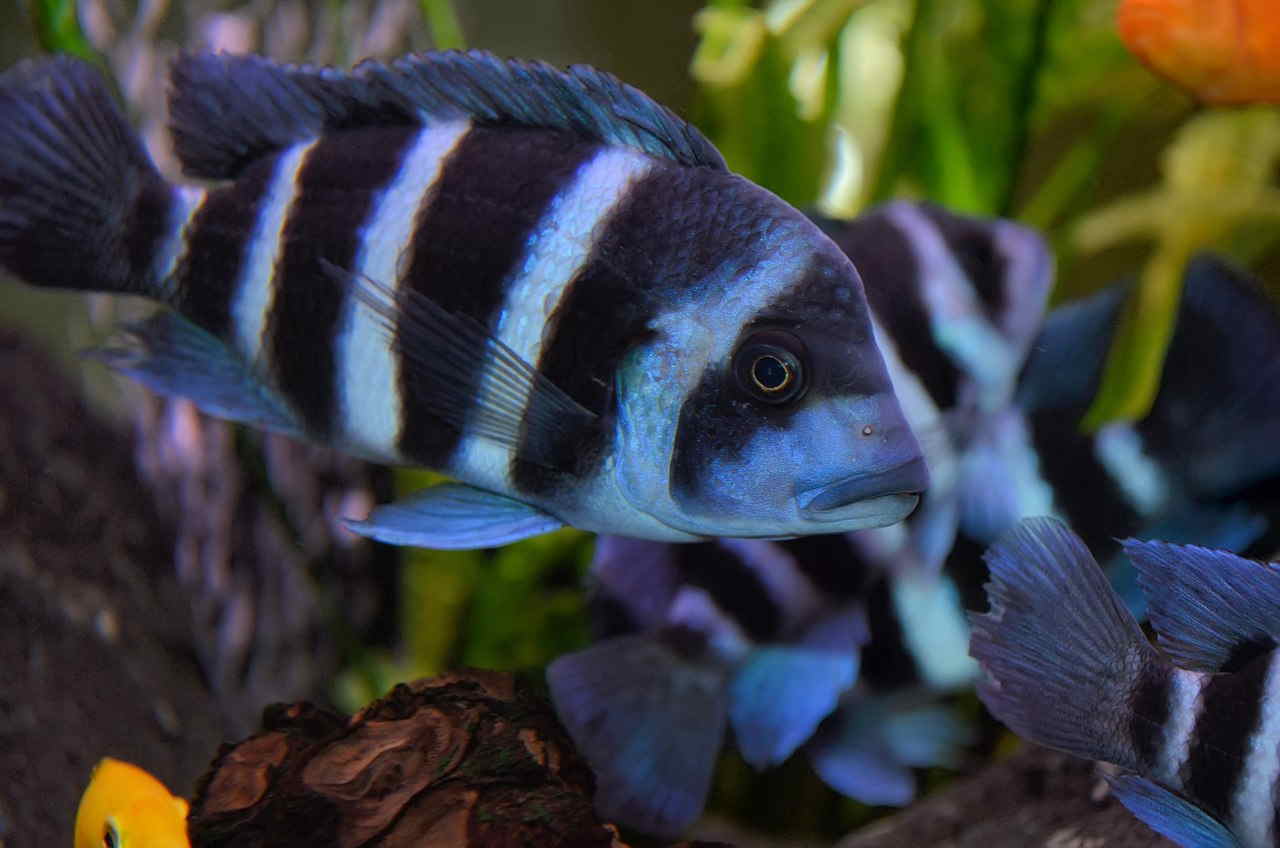
Sex differences: frontosa male vs female
Here are some general characteristics that can help differentiate between male and female frontosa cichlids:
Males tend to grow larger than females, with adult males reaching sizes of about 14-16 inches (35-40 cm) in length, while females are slightly smaller, usually up to 10 inches (25 cm). This size difference is one of the most noticeable traits when assessing the gender of frontosas.
In terms of body shape, males typically have a more elongated and slender form compared to females, who often exhibit a slightly rounder and fuller body. This distinction becomes more apparent as the fish mature.
One of the most prominent differences is the forehead hump. Males generally develop a larger and more pronounced forehead hump, which becomes increasingly noticeable as they mature. This feature is not only visually striking but can also indicate the male’s age and dominance within a group.
Coloration can be similar between sexes, with both males and females exhibiting a blue-black body adorned with white or blue stripes and spots. However, males often showcase more vibrant and intense coloration, especially during breeding periods. Variations in specific patterns and intensity of the stripes and spots can also depend on the geographic variant or locality.
Behavior is another key aspect in distinguishing between the two sexes. Males often display more territorial and aggressive behavior, particularly during breeding. They may engage in dominance displays, attempting to establish and defend territories within the aquarium. Females, while generally less aggressive, can still exhibit some territorial behavior, especially when breeding or protecting their eggs.
For a more accurate determination of sex, some enthusiasts look for additional characteristics such as the shape of the genital papilla. The genital papilla of males tends to be more pointed, while females usually have a broader and more rounded papilla. Observing these traits can provide further insight into the sex of frontosa cichlids, helping aquarists make informed decisions for breeding or social arrangements in their tanks.
Breeding
Breeding frontosa cichlids requires a significant commitment of time and effort, as these fish typically reach reproductive maturity around the age of three. Creating an ideal spawning environment is crucial for successful breeding, which involves a spacious tank of at least 400 liters (about 105 gallons). This tank should be equipped with rocks and hiding spots, as these structures provide the male with a defined territory and offer the female a sense of security while she chooses her breeding site.
Frontosa cichlids are somewhat unique among cichlid species in that they can also spawn in a community tank. This adaptability can be beneficial for aquarists who may not have a dedicated breeding setup. Maintaining optimal water conditions is essential for successful spawning; the pH should be maintained around 8, with a hardness of about 10° dGH, and the water temperature should be kept between 25 to 28 °C (77 to 82 °F). Frequent water changes and careful monitoring of water quality will help create a stable environment conducive to breeding.
During the breeding ritual, the male engages in elaborate displays, lowering his body and fluttering his fins to indicate to the female where she should lay her eggs. After the female lays her eggs, she takes them into her mouth to protect them, and in this mouthbrooding behavior, she collects milt from the male for fertilization. This behavior is particularly advantageous, as it ensures that the eggs are kept safe from potential predators until they hatch.
Unlike Malawi cichlids, which tend to spawn in a specific area of the tank, frontosa cichlids are known to breed throughout the aquarium. A single female can lay up to 80 eggs, each measuring around 6-7 mm in diameter. The incubation period for the eggs lasts between 40 to 54 days, depending on environmental conditions and water temperature. By the end of the 40 days, the juveniles are typically large enough and begin to leave their mother’s mouth, signaling their readiness for independence.
Interestingly, juvenile frontosa cichlids display a coloration similar to that of adult fish, although their colors may be slightly lighter and less pronounced. This gradual transition in color is an important aspect of their development. Once they are free-swimming, juveniles can be fed with baby brine shrimp, which is an excellent source of nutrition and helps them grow rapidly. In addition to brine shrimp, finely crushed flakes or pellets specifically designed for cichlid fry can be offered to ensure a balanced diet.
Providing proper care and attention during this early stage is vital for the survival and healthy growth of the young frontosa cichlids. This includes maintaining stable water parameters, avoiding overfeeding, and ensuring that the tank environment remains free from stressors. By fostering a nurturing atmosphere, aquarists can enhance the chances of successful development for these remarkable fish.